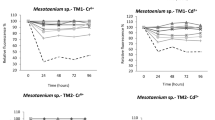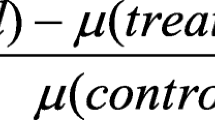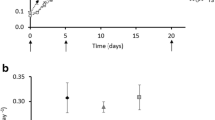Abstract
Sensitivity of four tropical cyanobacteria viz. Coelosphaerium sp., Synechococcus sp., Oscillatoria sp. and Chroococcus sp. to environmentally relevant concentrations of Cr6+, Cd2+ and Zn2+was assessed based on fluorescence change as a proxy for growth reduction. At 24 h exposure, the growth reduction inthe cyanobacteria followed the order: Zn2+ < Cr6+ ≤ Cd2+. Of the four cyanobacteria, Synechococcus was the most sensitive for Cr6+, where as Chroococcus was the most sensitive for Cd2+and Zn2+. Sensitivity was gradually decreased by 96 h implying the acquisition of tolerance by cyanobacteria to heavy metal ions with prolonged exposure.

Similar content being viewed by others
References
Altamirano M, García-Villada L, Agrelo M, Sánchez-Martín L, Martín-Otero L, Flores-Moya A, Rico M, López-Rodas V, Costas E (2004) A novel approach to improve specificity of algal biosensors using wild-type and resistant mutants: an application to detect TNT. Biosens Bioelectron 19:1319–1323
APHA (1999) Standard methods for the examination of water and wastewater. American Public Health Association, 20th edn. http://www.mwa.co.th/download/file_upload/SMWW_1000-3000.pdf. Accessed 20 Jan 2014
Bellinger EG (1992) A key to common algae, 4th edn. The Institution of Water and Environmental Management, London
Blindauer CA (2011) Bacterial metallothioneins: past, present, and questions for the future. J Biol Inorg Chemo 16(7):1011–1024
Buonasera K, Lambreva M, Rea G, Touloupakis E, Giardi MT (2011) Technological applications of chlorophyll a fluorescence for the assessment of environmental pollutants. Anal Bioanal Chem 401:1139–1151
Campanella L, Cubadda F, Sammartino MP, Saoncella A (2000) An algal biosensor for the monitoring of water toxicity in estuarine environments. Water Res 35(1):69–76
Chauvat CC, Chauvat F (2015) Responses to oxidative and heavy metal stresses in cyanobacteria: recent advances. Int J Mol Sci 16(1):871–886
Finney DJ (1971) Probit analysis, 3rd edn. Cambridge University Press, Cambridge
Hameed A, Hasnein S (2014) Role of cyanobacterial strains on Triticumae stivum growth under chromium stress in laboratory. Sci Int (Lahore) 26(4):1737–1742
Lee LH, Garrett R, Slusarczyk A, Perez J, Patel J, Chu TC (2013) Bioinformatic analyses of chromium tolerant genes in cyanobacteria and identification of chromium tolerant operon in Synechococcussp. IU 625. Growth 5(11):1–7
Loez CR, Topalián ML, Salibián A (1995) Effects of zinc on the structure and growth dynamics of a natural freshwater phytoplankton assemblage reared in the laboratory. Environ Pollut 88:275–281
McGrath SP, Smith S (1990) Chromium and nickel. In: Alloway BJ (ed) Heavy metals in soils. Wiley, New York, pp 125–150
Nies DH (1999) Microbial heavy metal resistance. Appl Microbiol Biotechnol 51:730–750
OECD TG 201 (2011) Organization for economic co-operation and development (OECD) guidelines for the testing of chemicals, section 2: effects on biotic systems test no. 201: freshwater alga and cyanobacteria, growth inhibition test OECD. OECD Publishing, Paris
Pereira M, Bartholomew MC, Sánchez-Fortún S (2013) Biosorption and bioaccumulation of chromium trivalent in Cr(III)-tolerant microalgae: a mechanism for chromium resistance. Chemosphere 93:1057–1063
Peterson HG, Nyholm H, Ruecker N (2005) Algal microplate toxicity test suitable for heavy metals. In: Blaise C, Ferard J (eds) Small scale freshwater toxicity investigations. Springer, Netherlands, pp 243–270
Singh S, Shrivastava AK, Singh VK (2014) Arsenic and cadmium are inhibitors of cyanobacterial dinitrogenase reductase (nifH1) gene. Funct Integr Genomics. doi:10.1007/s10142-014-0375-2
Waterbury JB (2006) The cyanobacteria-isolation, purification and identification. In: The prokaryotes Springer US, 4:1053–1073
Wong PTS, Trevors JT (1988) Chromium toxicity to algae and bacteria. In: Nriagu JO, Nieboe E (eds) Chromium in the natural and human environments. Wiley, New York, pp 335–348
Wong LS, Lee YH, Surif S (2013) Performance of a cyanobacteria whole cell-based fluorescence biosensor for heavy metal and pesticide detection. Sensors 13:6394–6404
Zhou Q, Zhang J, Fu J, Shi J, Jiang G (2008) Biomonitoring: an appealing tool for assessment of metal pollution in the aquatic ecosystem. Anal Chim Acta 606:135–150
Acknowledgments
Financial support by the National Research Council (NRC) Sri Lanka (Grant No. 12-092). Atomic absorption spectrometer purchased from the Equipment grant (RG/2012/EQ/12) of the National Science Foundation of Sri Lanka was used for metal analysis.
Author information
Authors and Affiliations
Corresponding author
Electronic supplementary material
Below is the link to the electronic supplementary material.
Rights and permissions
About this article
Cite this article
Munagamage, T., Rathnayake, I.V.N., Pathiratne, A. et al. Sensitivity of Four Cyanobacterial Isolates from Tropical Freshwaters to Environmentally Realistic Concentrations of Cr6+, Cd2+ and Zn2+ . Bull Environ Contam Toxicol 96, 816–821 (2016). https://doi.org/10.1007/s00128-016-1809-4
Received:
Accepted:
Published:
Issue Date:
DOI: https://doi.org/10.1007/s00128-016-1809-4




